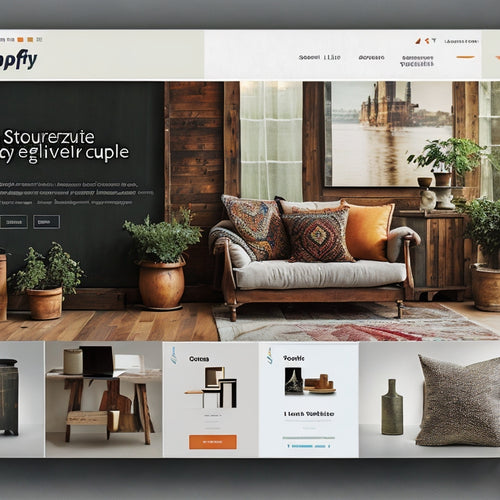Functions of Shoppable Video Apps
Share
In today's digital age, e-commerce and digital marketing strategies are continuously evolving to enhance consumer engagement and drive conversion rates.
Shoppable video apps have emerged as a powerful tool in this landscape, offering a seamless shopping experience that integrates with social media platforms.
With the ability to track analytics and provide valuable insights, these apps have revolutionized the way brands connect with their target audience.
This article delves into the functions of shoppable video apps, exploring their benefits and potential impact on e-commerce and digital marketing strategies.
- Tailoring content to individual viewers and providing personalized recommendations are important functions of shoppable video apps.
- Leveraging data-driven insights and analyzing viewer behavior and engagement in real-time are crucial for optimizing shoppable videos.
- Increasing viewer engagement through personalized recommendations and driving more sales are key objectives of shoppable video apps.
- Enhancing the user experience, maximizing conversions, and making data-driven decisions are essential for the success of shoppable video apps.
Seamless Shopping Experience
The seamless shopping experience in shoppable video apps refers to the ability of users to easily browse and purchase products directly within the app without disruptions or inconveniences. These apps aim to provide a personalized and convenient shopping journey for users, enhancing their overall shopping experience.
One key feature that contributes to the seamless shopping experience is personalized recommendations. Shoppable video apps utilize algorithms and user data analysis to offer tailored product suggestions based on individual preferences and browsing history. By providing relevant recommendations, these apps save users time spent searching for products, making their shopping experience more efficient and enjoyable.
Another important aspect of the seamless shopping experience is a simplified checkout process. Shoppable video apps streamline the purchasing process by allowing users to add items to their cart directly from the video content. This eliminates the need for users to navigate away from the app or website, reducing friction in the buying process. Additionally, some apps offer one-click purchasing options or saved payment information, further expediting checkout for returning customers.
Overall, shoppable video apps strive to create a seamless shopping experience by incorporating personalized recommendations and simplifying the checkout process. By offering a convenient and tailored journey, these apps enhance customer satisfaction and increase engagement with e-commerce platforms.
Enhanced Engagement
Enhanced engagement is a key aspect of the functionality provided by shoppable video applications. These apps offer a range of interactive features that captivate viewers and encourage them to actively participate in the shopping experience. For instance, users can click on products within the video to obtain more information or make purchases directly. This level of interactivity not only enhances user engagement but also allows for a seamless transition from watching a video to making a purchase.
Shoppable video apps also leverage personalized recommendations to further engage users. By analyzing user data, these apps are able to understand individual preferences and tailor product suggestions accordingly. This personalized approach creates a sense of belonging for users as they feel understood and catered to on an individual level.
Furthermore, statistics show that enhanced engagement through shoppable videos leads to increased conversion rates and sales. According to research conducted by Wyzowl, 84% of consumers have made a purchase after watching a brand's video. The ability for users to directly interact with products within the video eliminates any barriers between inspiration and action.
In conclusion, shoppable video apps excel at providing enhanced engagement through their interactive features and personalized recommendations. By leveraging these capabilities, brands can create immersive experiences that resonate with their audience, leading to higher conversion rates and increased sales.
Increased Conversion Rates
Increased conversion rates are a significant outcome of the interactive and personalized features offered by shoppable video applications. These apps employ various strategies to engage viewers and guide them through the purchasing process, resulting in higher conversion rates for businesses.
One key feature that contributes to increased conversions is personalized recommendations. Shoppable video apps utilize algorithms to analyze viewer data and provide tailored product suggestions based on their preferences and browsing history. By offering relevant recommendations, these apps enhance the user experience, making it more likely for viewers to make a purchase.
Additionally, interactive product displays play a crucial role in driving conversions. Shoppable videos allow users to click on specific products within the video itself, leading them directly to the product page for more information or to complete a purchase. This seamless integration between video content and e-commerce platforms eliminates friction in the customer journey, increasing the likelihood of conversion.
Studies have shown that shoppable videos can significantly boost conversion rates compared to traditional static images or text-based ads. For example, research conducted by Wyzowl found that 74% of consumers who watched an explainer video about a product subsequently made a purchase.
In conclusion, shoppable video apps' interactive and personalized features contribute to increased conversion rates. Personalized recommendations and interactive product displays create an engaging shopping experience that guides viewers towards making a purchase decision. By leveraging these tools effectively, businesses can optimize their e-commerce strategies and drive higher conversions.
Social Media Integration
Social media integration plays a pivotal role in expanding the reach and visibility of interactive and personalized features offered by applications that allow for shopping within videos. By seamlessly integrating with popular social media platforms, shoppable video apps can tap into the vast audience base and engage users in a more meaningful way.
One of the key advantages of social media integration is its ability to leverage social media marketing techniques. Shoppable video apps can utilize various social media marketing strategies such as targeted advertisements, sponsored posts, and influencer collaborations to promote their products or services. For example, influencers can create engaging content featuring shoppable videos on their social media profiles, reaching their followers directly and increasing brand awareness.
Moreover, social media integration enables shoppable video apps to benefit from user-generated content. Users can share their experiences with the products showcased in these videos through comments, likes, shares, or even by creating their own videos using hashtags associated with the app or brand. This user-generated content not only provides valuable feedback but also serves as authentic product endorsements that further enhance brand credibility.
In conclusion, integrating shoppable video apps with social media platforms offers numerous benefits for both brands and consumers. It allows brands to expand their reach through targeted advertisements and influencer collaborations while providing users with an immersive shopping experience. By leveraging the power of social media marketing and user-generated content, these apps have the potential to revolutionize e-commerce and digital marketing strategies.
Analytics and Tracking
Analytics and tracking play a crucial role in the success of shoppable video apps.
By monitoring and analyzing viewer behavior and engagement, businesses can gain valuable insights into what resonates with their audience and make data-driven decisions to optimize their shoppable videos.
For example, by tracking metrics such as click-through rates, conversion rates, and average time spent watching, companies can identify patterns and trends that allow them to refine their videos for maximum effectiveness.
These analytics provide objective and informative feedback that enables businesses to continuously improve their shoppable videos and enhance their overall e-commerce or digital marketing strategies.
Monitor and analyze viewer behavior and engagement
One important aspect of shoppable video apps is the ability to monitor and analyze viewer behavior and engagement. This feature allows businesses to gain valuable insights into their audience's preferences, interests, and shopping habits.
By tracking viewer retention rates, businesses can determine the effectiveness of their shoppable videos in keeping viewers engaged and interested.
Additionally, shoppable video apps provide personalized recommendations based on viewer behavior and previous interactions with the app. These recommendations help businesses tailor their content to individual viewers, increasing the likelihood of conversion and customer satisfaction.
For example, if a viewer frequently watches beauty tutorials on a shoppable video app, they may receive personalized recommendations for makeup products or skincare routines that align with their interests.
By closely monitoring viewer behavior and engagement, businesses can optimize their shoppable video strategies to maximize conversions and enhance the overall user experience.
Optimize shoppable videos based on data-driven insights
To enhance the effectiveness of shoppable videos, businesses can optimize their content by leveraging data-driven insights. By analyzing viewer behavior and engagement through real-time data analysis, businesses can gain valuable insights into what aspects of their shoppable videos are resonating with viewers and driving conversions.
This data can then be used to personalize recommendations and optimize the content accordingly. For example, if the data shows that viewers tend to click on specific products or engage more with certain types of content, businesses can tailor their shoppable videos to highlight those products or create similar engaging content.
By using personalized recommendations based on data-driven insights, businesses can increase viewer engagement and ultimately drive more sales through their shoppable video apps.
Frequently Asked Questions
How do shoppable video apps provide a seamless shopping experience for users?
Shoppable video apps offer a seamless shopping experience for users by integrating product information and purchasing options directly into the videos. This allows users to easily browse and buy products without interrupting their viewing experience, enhancing user satisfaction and convenience.
What are the key features that enhance engagement in shoppable video apps?
Key features that enhance engagement in shoppable video apps include increased user interaction through interactive elements like clickable hotspots, quizzes, and polls, as well as personalized recommendations based on user preferences and browsing history.
How do shoppable video apps contribute to increased conversion rates?
Shoppable video apps contribute to increased sales and interactive shopping experiences. By allowing users to directly purchase products showcased in videos, these apps create a seamless and convenient path to conversion, enhancing customer engagement and driving higher conversion rates.
Can shoppable video apps integrate with social media platforms and if so, which ones?
Shoppable video apps can integrate with popular social media platforms such as Instagram, Facebook, and YouTube. This integration allows retailers to reach a wider audience, increase brand visibility, and drive more traffic to their e-commerce websites.
What kind of analytics and tracking capabilities do shoppable video apps offer to businesses?
Shoppable video apps offer a range of analytics capabilities and tracking features to businesses. These include metrics such as click-through rates, conversion rates, viewer engagement, and customer behavior analysis, providing valuable insights for e-commerce and digital marketing strategies.
Related Posts
-

How Do I Import Products From Any Website to Shopify With This App
This article explores the process of importing products from any website to Shopify using a specific app. It aims to...
-

What Are the Best Shopify SEO Strategies
The objective of this article is to analyze and present the best Shopify SEO strategies for e-commerce success. By e...
-

Pros and Cons of AI: Boosting Innovation, Raising Concerns
The topic at hand concerns the advantages and disadvantages of artificial intelligence (AI), exploring its potential...


